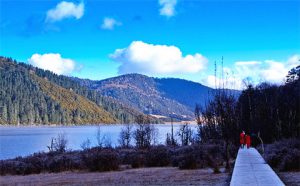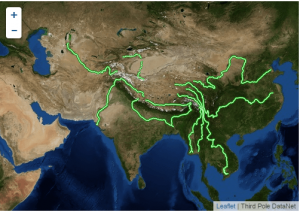China’s central government is reforming the way major tourist attractions are run. It plans to create a unified national parks management system in a bid to halt environmental damage within its protected areas. The new, unified system will cut across the local and departmental interests of existing operators to try to ensure that these parks are run for the public benefit.
The National Development and Reform Commission (NDRC) has already identified seven of China’s most famous tourist spots to test the new system – they include the Great Wall, the colourful, mineral-rich mountain lakes of Jiuzhaigou in Sichuan, and the needle-like rock formations at Zhangjiajie in Hunan province. A draft policy document is also being circulated around government bodies and independent groups for comment.
Fragmented system
The current, messy system came about in a piecemeal fashion after the creation of China’s first “national park” in 2006, when the Tibetan prefecture of Diqing used local legislation to designate the Shangrila Pudacuo National Park. However, local governments did not actually have the right to declare a park as “national”. In 2007, the Yunnan provincial government copied the idea and in 2008 the State Forestry Administration (SFA) sanctioned Yunnan as a test site for the establishment of national parks.
In 2008, the Ministry for Environmental Protection (MEP) and the National Tourism Administration approved the Heilongjiang Tangwang River National Park in Manchuria. And the Ministry of Construction (now the Ministry of Housing and Urban-Rural Development, MHURD) renamed its “National Scenic Areas” as “national parks” in the English translation.
As a result, China now has many so-called national parks, all managed by different bodies. By February 2009, there were 710 national forest parks alone, plus wetland parks, geo parks and archeological parks. But they have failed to halt environmental degradation, and the public is angered by sky-high ticket prices, according to Xinhua news agency.
National framework
To solve the problem, the establishment of a national parks system was proposed in the November 2013 “Decision of the CPC Central Committee on Comprehensively Deepening Reforms”.
A draft discussion document on the proposals is now being circulated; the process kicked off at a Beijing forum on environmentalism and national parks on October 21. It comes ahead of a major world meeting on protected areas in Australia this month, the once-a-decade IUCN World Parks Congress.
The document proposes that the State Council create a body for overall management of national parks and reserves, doing away with the existing regional and departmental divisions and creating a comprehensive and unified management system. The new system should stand above departmental interests in order to improve environmental protection; experts from all government departments that currently control the so-called national parks attended the October forum.
Extra money needed
The draft says that national parks are part of China’s national image; are natural heritage not private assets; and must protect large-scale ecosystems, allowing for research, education and tourism. They should not be run for company profits, or as drivers of development for local government, says Tsinghua University’s Yang Rui, adding that is essential for funding and management to come directly from central government.
Su Yang, a researcher at the Social Development Department of the State Council’s Development Research Centre, also told chinadialogue the reform will require state funding if it is to succeed in changing the management system.
The lack of a unified system has created big problems. Although China’s nature reserves cover 20% of its land, the environment is still worsening.
Su also told chinadialogue that a national parks system which runs parks for the public good would mean lower ticket prices: “Entry to Pudacuo National Park costs 190 yuan. How can that be acceptable?”
Pricing rules ignored
Tourists complained of excessive entry fees at scenic spots during 2014’s October National Week holiday, according to Xinhua news agency. In 2007, the NDRC ruled that ticket prices should rise only once every three years, but parks bump prices up whenever possible. During the holiday week, tickets to Lijiang Jade Dragon Snow Mountain park in Yunnan jumped from 105 yuan to 130 yuan, while entry to the sexually suggestive rock formations and Buddhist temples of Guangdong province’s Danxia Mountain Geopark rose by 40 yuan to 200 yuan. Average entry costs to a 5A-grade park, (the top listing), is now over 100 yuan per person, or roughly US$16.
Assessing the draft discussion document, Zhu Chun of the International Union for the Conservation of Nature (IUCN), said a national management body would provide a rare chance to improve the protection of nature and promote environmentalism.
Fan Zhiyong, chief researcher at WWF China, said the biggest problem for wildlife conservation in China is habitat fragmentation. Mining, road construction and hydropower all destroy habitats, badly damaging wildlife and plant populations. National parks need to be big enough to link the fragmented habitats of animal populations.
Environmental heritage
Tsinghua University’s Yang stressed the importance of public participation in environmental protection, saying it cannot rely solely on research scientists staffing nature reserves, but needs widespread participation. National parks can provide ordinary people with a window onto conservation and make ideal venues for environmental education.
Representatives from eight government bodies attended the October 21 forum — the NDRC, Ministry of Environmental Protection, State Forestry Administration, State Oceanic Administration, Ministry of Water Resources, State Administration of Cultural Heritage, Ministry of Land and Resources, MHURD – as well as international bodies, the Chinese Academy of Sciences and other research institutes and think-tanks.








